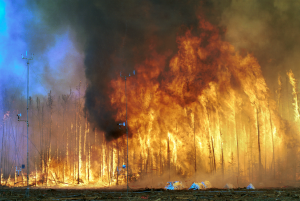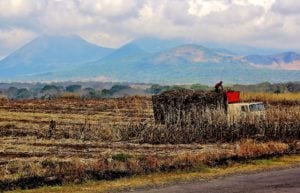Preventing deforestation, soil erosion and desertification are key to tackling climate change and ensuring future food and water supplies, scientists stressed this week.
In a major report looking at how bad management of land causes climate change and worsens the impact of extreme weather, the IPCC warned that human activity is affecting more than 70% of the ice-free surface of the world. Up to 33% of land is used for the production of food, animal feed, fibre, timber and energy, while agriculture accounts for around 70% of freshwater use.
The report highlights that land is both a source and a sink of greenhouse gases (GHGs). Agriculture, forestry and other land use emissions generate 23% of net GHG emissions, including methane, nitrous oxide and carbon dioxide, the scientists found. This rises to 37% when all activities associated with the pre- and post-production of food, such as transport, are included.
At the same time, natural land processes absorb around a third of GHGs emitted by burning fossil fuels and industrial processes.
As well as increasing GHG emissions, land management practices are increasing deforestation, desertification and depletion of soils. Erosion from agricultural fields is estimated to be up to 100 times higher than the rate of soil formation, posing a threat to food production. Degraded land becomes less productive, restricting what can be grown, while also reducing the soil’s ability to absorb carbon.
The annual area of land in a state of drought has increased by more than 1% a year between 1961 and 2013, while the frequency and intensity of dust storms has increased over the past few decades, negatively impacting human health, the IPCC found.
The likelihood, intensity and duration of extreme heat and rainfall can be significantly impacted by changes in land conditions such as deforestation and desertification, the scientists noted. Changes in land can affect temperature and rainfall in regions as far as hundreds of kilometres away.
In dry areas, climate change and desertification are projected to reduce crop and livestock productivity, change the types of plants that grow there and reduce wildlife. Some 178 million people are at risk of water stress, drought intensity and habitat degradation if the world warms by 1.5C, increasing to 220 million at 2C warming, and 277 million at 3C warming.
The impacts of desertification will be worse in Asia and Africa, while North and South America, the Mediterranean, southern Africa and central Asia will be more at risk of wildfire. A fall in crop yield is the biggest threat in the tropics and subtropics, the report states.
Land must be managed more sustainably in order to reverse these risks, the IPCC said. “In a future with more intensive rainfall the risk of soil erosion on croplands increases, and sustainable land management is a way to protect communities from the detrimental impacts of this soil erosion and landslides,” said Kiyoto Tanabe, co-chair of the IPCC’s task force on national GHG inventories.
Indigenous rights
Significantly, the report marks the first time the IPCC has recognised the importance of indigenous peoples as stewards of the land. Agricultural practices that include indigenous and local knowledge can simultaneously combat desertification, land degradation and climate change, while improving food security and conserving biodiversity. Businesses, consumers and policymakers should work with indigenous people on better land management, it added.
Indigenous and community leaders praised the long-awaited recognition of their role, and the need for their rights to be strengthened. Representatives from 42 countries, spanning 1.6 billion hectares of land managed by indigenous peoples, issued a statement to the IPCC.
“Our existence has always been threatened when our lands are desired by governments and corporations,” said Sonia Guajajara, executive coordinator of Articulação dos Povos Indígenas do Brasil.
“These interests would kill us or lock us up so that our lands can be changed to fit whatever scheme has been concocted. Now with this report there is recognition that how we have safeguarded our forests and lands benefits the entire world – but our rights to exist and manage these lands need to be strengthened. Will the world listen?” she said.
Approximately 218 gigatonnes of carbon are stored in the tropical and subtropical forests of indigenous peoples and communities, with at least a third of this carbon in areas which lack formal recognition of their land rights, the statement read.
Dietary changes urgently needed
Expanding areas for agriculture and forestry, and increasing productivity, has supported consumption and food availability for a growing population, but also contributed to increasing GHG emissions, declining biodiversity and shrinking ecosystems such as forests, savannahs, grasslands and wetlands, the report states.
The supply of vegetables and meat per person has risen by around one third since 1961. However, around 25-30% of total food produced is lost or wasted, increasing GHG emissions. Changing eating habits have contributed to around two billion adults being overweight or obese, while 821 million are undernourished, the scientists noted.
A move to more plant-based diets based on grains, legumes, fruits and vegetables, nuts and seeds, with meat and dairy produced in low-GHG emission systems, is a major opportunity for mitigating climate change while significantly improving human health.
Such dietary changes could free several million square kilometres of land, and reduce emissions by 0.7-8 gigatonnes of CO2 equivalent a year, the scientists said.
The report also points out that land could make a valuable contribution to climate-change mitigation through the cultivation of crops for bioenergy, or planting trees to absorb CO2. However, there are limits to the deployment of these solutions, as widespread use at the scale of several million square kilometres could increase desertification and land degradation, damaging food security and sustainable development, it warned.
Co-benefits stressed
Upfront investments in sustainable land management practices and technologies range from approximately US$20 to $5,000 per hectare, with a median estimated at around US$500 per hectare, the IPCC estimated.
Restoring land can bring about benefits that are three to six times these costs, with many sustainable land management technologies and practices profitable within three to ten years, it said. Investments in sustainable land management can enhance crop yields, increase the economic value of pasture and livelihoods, improve climate change adaptation and mitigation, and benefit wildlife.
However, delaying action could cause irreversible loss in the ability of land to grow food, support human health and provide habitable places, while also accelerating global warming. This would cause increasingly significant economic impacts on many countries in many regions of the world, the IPCC warned.
Hans-Otto Pörtner, co-chair of one of the IPCC working groups behind the report said: “Land already in use could feed the world in a changing climate and provide biomass for renewable energy, but early, far-reaching action across several areas is required.”
The IPCC’s report will be a key scientific input into forthcoming climate and environment negotiations, such as the UN Convention to Combat Desertification in India, in September, and the UN Framework Convention on Climate Change conference in Chile, in December.








